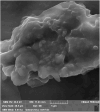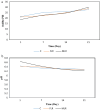Encapsulation of Lacticaseibacillus rhamnosus by Extrusion Method to Access the Viability in Saffron Milk Dessert and Under Simulated Gastrointestinal Conditions
- PMID: 39619975
- PMCID: PMC11606897
- DOI: 10.1002/fsn3.4510
Encapsulation of Lacticaseibacillus rhamnosus by Extrusion Method to Access the Viability in Saffron Milk Dessert and Under Simulated Gastrointestinal Conditions
Abstract
The effectiveness of probiotics in delivering health benefits may be associated with their capacity to maintain a minimum concentration of 106 CFU/g during food storage and to successfully colonize the gastrointestinal tract (GI). Lacticaseibacillus rhamnosus (LR) is a probiotic that does not exhibit adequate stability under harsh conditions. To enhance the survival capacity of LR during gastrointestinal storage, alginate (ALG) was used as a primary encapsulating layer through extrusion microencapsulation. Subsequently, camelina seed mucilage (CSM) and camelina seed protein (CSP) were applied as secondary layers at varying concentrations (0%-4%). Among the tested formulations, ALG-CSM-CSP (1.5%, 4%, 4% w/w) exhibited significantly higher encapsulation efficiency (94.15%) and provided appropriate LR encapsulation in SEM image. Three saffron milk desserts (SMD) containing free LR (FLR), microencapsulated LR (MLR), and a control (C) were prepared, followed by physicochemical and microbiological assessments of the samples. The result showed that at the end of storage, SMD had the lowest pH (6.21), the highest acidity (30°D), and maintained the permissible limit of probiotic bacteria (6.7 log cfu/mL) among the samples. In GI, the MLR and FLR survival rates were 43% and 45.4%, respectively on the 14th day of storage, respectively. The MLR hardness (313.70 g), adhesiveness (2.01 mJ), chewiness (9.36) and gumminess (58.8) had the greatest values among the samples. Moreover, SEM images showed a relatively denser structure for MLR. In conclusion, this study highlights the potential of CSM and CSP to protect probiotics, offering valuable insights for developing new functional foods with improved survival during storage and GI.
Keywords: Lacticaseibacillus rhamnosus; extrusion; saffron milk dessert; simulated gastrointestinal condition.
© 2024 The Author(s). Food Science & Nutrition published by Wiley Periodicals LLC.
Conflict of interest statement
The authors declare no conflicts of interest.
Figures






Similar articles
-
Date yogurt supplemented with Lactobacillus rhamnosus (ATCC 53103) encapsulated in wild sage (Salvia macrosiphon) mucilage and sodium alginate by extrusion: The survival and viability against the gastrointestinal condition, cold storage, heat, and salt with low pH.Food Sci Nutr. 2024 Aug 1;12(10):7630-7643. doi: 10.1002/fsn3.4304. eCollection 2024 Oct. Food Sci Nutr. 2024. PMID: 39479610 Free PMC article.
-
The Biochemical, Microbiological, Antioxidant and Sensory Characterization of Fermented Skimmed Milk Drinks Supplemented with Probiotics Lacticaseibacillus casei and Lacticaseibacillus rhamnosus.Microorganisms. 2023 Oct 9;11(10):2523. doi: 10.3390/microorganisms11102523. Microorganisms. 2023. PMID: 37894180 Free PMC article.
-
Gum Arabic/Chitosan Coacervates for Encapsulation and Protection of Lacticaseibacillus rhamnosus in Storage and Gastrointestinal Environments.Probiotics Antimicrob Proteins. 2024 Dec;16(6):2073-2084. doi: 10.1007/s12602-023-10152-9. Epub 2023 Sep 5. Probiotics Antimicrob Proteins. 2024. PMID: 37668856
-
Preparation of a Lactobacillus rhamnosus ATCC 7469 microencapsulated-lactulose synbiotic and its effect on equol production.Food Funct. 2024 Sep 16;15(18):9471-9487. doi: 10.1039/d4fo02690j. Food Funct. 2024. PMID: 39193624
-
A review of the microencapsulation techniques for the incorporation of probiotic bacteria in functional foods.Crit Rev Food Sci Nutr. 2021;61(9):1515-1536. doi: 10.1080/10408398.2020.1761773. Epub 2020 May 13. Crit Rev Food Sci Nutr. 2021. PMID: 32400195 Review.
Cited by
-
Gellan Fluid Gel Embedded in Alginate Bead System: A New System for Encapsulation of Limosilactobacillus reuteri and Its Application in Sour Cherry Juice.Food Sci Nutr. 2025 May 14;13(5):e70199. doi: 10.1002/fsn3.70199. eCollection 2025 May. Food Sci Nutr. 2025. PMID: 40376599 Free PMC article.
References
-
- Amira, S. , Sifour M., Ouled‐Haddar H., et al. 2019. “Effect of Different Food Stress Conditions on the Viability of Encapsulated Lactobacillus plantarum and Lactobacillus casei Isolated From Klila (An Algerian Traditional Fermented Cheese).” Journal of Microbiology, Biotechnology and Food Sciences 9, no. 1: 38–43. 10.15414/jmbfs.2019.9.1.38-43. - DOI
-
- Azeem, M. , Saeed F., Afzaal M., et al. 2023. “Encapsulation of Probiotics in Solid Lipid Micro Particle for Improved Viability and Stability Under Stressed Conditions.” International Journal of Food Properties 26, no. 1: 1612–1623. 10.1080/10942912.2023.2223776. - DOI
-
- Beldarrain‐Iznaga, T. , Villalobos‐Carvajal R., Leiva‐Vega J., and Armesto E. S.. 2020. “Influence of Multilayer Microencapsulation on the Viability of Lactobacillus casei Using a Combined Double Emulsion and Ionic Gelation Approach.” Food and Bioproducts Processing 124: 57–71. 10.1016/j.fbp.2020.08.009. - DOI
-
- Borhanpour, F. , Sekhavatizadeh S. S., Hosseinzadeh S., Hasanzadeh M., Golmakani M.‐T., and Moharreri M.. 2021. “Effect of Microencapsulated Chavil (Ferulago angulata) Extract on Physicochemical, Microbiological, Textural and Sensorial Properties of UF‐Feta‐Type Cheese During Storage Time.” International Journal of Food Engineering 18, no. 1: 53–66. 10.1515/ijfe-2021-0198. - DOI
LinkOut - more resources
Full Text Sources
Molecular Biology Databases

